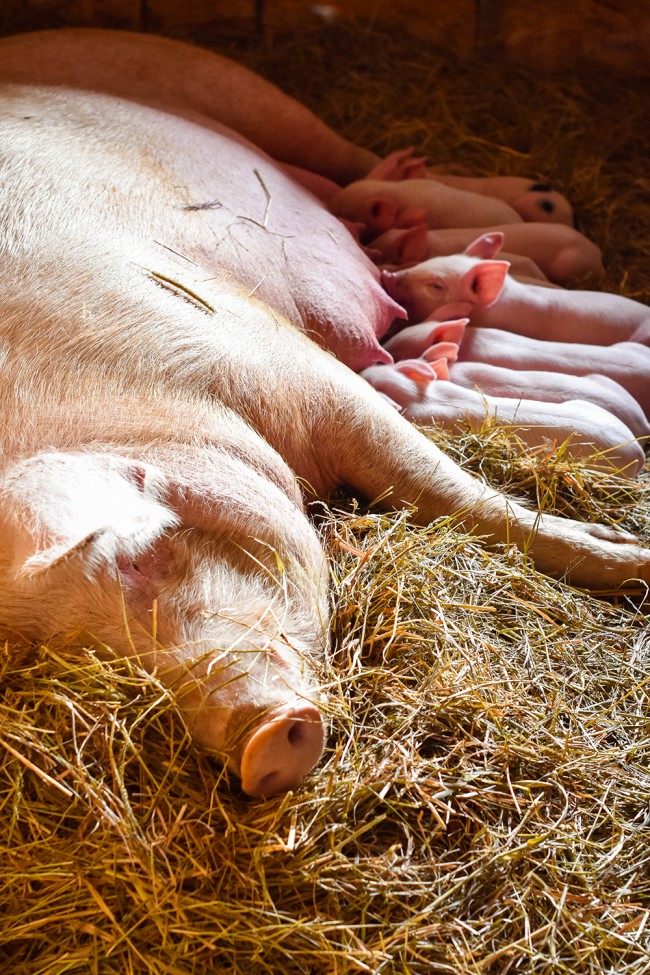
Photo Credit: Andrea Eastman
The Good Life
Back when backyard chickens was the newest trend for city folks, my Vancouver friend was up visiting Terrace and I thought it would be neat to show her a little country. I knew some friends who had just got chickens, so we decided to stop by and check them out.
What I failed to understand at the time, however, is there’s a significant difference between chickens that lay eggs and meat birds—chickens raised for eating. Many meat birds are sort of freaks of nature. Bred to bulk up quickly, their lives are short and, at the end, fat. Depending on the breed, the birds can be butchered and eaten after just two months. By that point, some are so large that they lumber instead of walk.
It was that stage of life my friends’ meat birds were at when my naïve city friend and I arrived to admire them. Expecting sweet, cooing chickens strutting like royalty (picture a Disney movie), we were shocked to find feathery meatballs with beaks.
That was the first of many instances over my years of living in the North that I’ve realized growing your own food, especially when it comes to raising animals, is admirable but not for the faint of heart. And it definitely requires a certain level of grit.
The big jump In the last decade, many friends and colleagues in northwest BC have bought properties, anywhere from 10 to 150 acres, and they’ve become farmers. They’re buying tractors, building barns, growing gardens, and raising a variety of animals: ducks, turkeys, pigs, goats, sheep, cows, horses, and bees to name a few. Some of the animals help with labour and others are for recreation—but most are for food.
Many of our farming friends have never farmed before and continue to work full-time. Their lives are busy. In many ways, they’re also idyllic. After a long day, they come home to their private sanctuary. They visit and feed their quirky, beloved animals. Then they pick salad straight from their gardens—squiggly orange carrots, ripe red tomatoes, and dewy lettuce in all hues of green. Dinner is salad with roast chicken or pork chops, meat from animals they’ve raised and butchered themselves. On weekends, breakfast is fresh eggs with the largest and yellowest yolks you’ve ever seen, and thick, homemade bacon. Coffee is sipped on the porch, looking out at the horses, and the forests and mountains beyond.
My family and I love to sleep over at these friends’ homes for obvious reasons. But there’s much more to farming, including many smelly, muddy, and bloody realities, that aren’t quite as appealing.
First, farming is a lot of work. It can be mentally and physically exhausting. It’s also unpredictable and costly. And at times it can be sad. Animals get sick, or die in childbirth, or are killed by predators. Most simply follow the lifecycle for which they were destined, and are sent to the abattoir or butchered by the farmers themselves.
There’s a certain kind of gumption and commitment to the farming lifestyle that I don’t think I could hack. Others thrive on it.
Where food is from Carla and Eric Lennert moved to Terrace in 2006. They bought their first home a year later, a property just outside of town, a piece of land just shy of an acre. They got started with farming when their neighbours were raising chickens and they decided to partner up.
“We got chickens, the ‘gateway animal’,” says Eric. “Then we got meat chickens. Then we got turkeys.”
Carla says they wanted to know where their meat was coming from, especially when they had kids.
“It became more important to give them food raised in the backyard,” she explains. “I think kids need to know where food comes from so they understand why we eat what we eat.” As for the kids saying goodbye? “They understand that death is just part of life. I know it can be sad for them sometimes, but they don’t typically get upset about it. They understand that’s the way it is and sometimes animals die.”
In 2014, the Lennerts bought a much bigger 10-acre property in Old Remo, a well-established agricultural area not far from Terrace. It has a log home, a shop, and several outbuildings. They’ve cleared some land, with plans to clear more, and built a paddock, barn, and garden. They now have a mix of chickens, ducks, turkeys, bees, pigs—and a pair of horses.
“Now that we’ve moved to a bigger property, it gives us the opportunity to become creative with what we do,” says Carla.
Time for hobbies has dwindled, though, says Eric, half-joking. “I don’t go fishing anymore. I don’t play hockey anymore. I don’t really do anything anymore, unless it’s around here.”
But Carla adds: “That’s by choice. Those aren’t the things that are valuable to us at the end of the day. We spend a lot of time working, both full time at our jobs and here. But I don’t feel the sacrifices outweigh the benefits. The benefits are better.
“And when people come to dinner, it’s something to take pride in,” she says. “You become proud of farm to table.”
Only one bad day Carmen and Naomi Nyuli bought their 35-acre property in the Driftwood area near Smithers about four years ago.
“There was nothing on the land. It was completely forested,” says Naomi. “We figured out where we were going to place the utilities, buildings, pastures, and infrastructure, researching everything along the way.”
Now they’ve got a shop, a half-finished house, a large garlic plot, horse pens, and a huge sheep enclosure. Total animals include two cats, two dogs, two horses, and, for now, 19 Suffolk sheep.
Naomi says people are always calling them crazy because it’s so much work, but they couldn’t be happier. “I love seeing our dreams come to fruition. I love waking up in the morning and seeing the horses, and the mountain vista, taking time from my computer work to interact with the animals and tend the garden. There’s nowhere I’d rather be.”
The Nyulis long-term plan is to run an agri-tourism business on the property, hence the name “Blackhorse Ranch and Retreat”. They want to build a refuge where visitors can rent an off-grid cabin and unplug. To comply with zoning laws, they need farm status. And to get farm status, they must make $2,500 in annual farm income. Hence, onsite farrier services, the garlic patch, and the sheep.
The average death rate for sheep breeding is 20 percent. That means one of every five lambs born is expected to die. Their first year, the Nyulis lost even more than that.
“It was scary, like ‘What did I do? Am I just killing things?’,” says Carmen. “Going into the second year, I was terrified.”
The second year went well, however, as the couple set up a better feed and barn system. “The ewes were more experienced, and they were more comfortable with me,” adds Carmen.
A retired guide outfitter, he’s accustomed to animals and death. Still, he says, “This has been a real learning process, full of ups and downs.”
As for sending the animals to the abattoir, he seems grounded. “When it comes to outfitting, people think you embrace the killing, but that’s not what you do. You embrace how the animal moves, walks, gets up. And that’s the same thing with the sheep. It’s not about killing. That’s just part of the job. That’s their life journey.”
Naomi struggles a little more when it’s time for the animals to go but says she’s learning to manage her emotions.
“I don’t want to say I’m hardened to it but I’m not crying at the drop of a dime. This is something that we raised and is appreciated by those who eat the meat. As someone once said: ‘They only have one bad day’.”
The colour red The first time I watched my friends slaughter chickens more than a decade ago, the whole thing seemed crazy to me. I was fascinated and disgusted at the same time. When it was our time to help, I was surprised how quickly my queasy stomach settled as I got into work mode.
To kill a meat bird, you place the chicken upside down in a traffic cone set in a wooden board. Then you cut off the chicken’s head with a knife and let it bleed out. You have to wait a few seconds for the bird’s feet to stop kicking. Then you plunge the carcass in boiling water to loosen the feathers and bang the body against a rotating feather-plucking machine. Finally, you lay it on a table and pull out the guts. It’s all done outside and the more people, the better—especially if you are killing lots of chickens in one day.
My job that first day was to remove the guts. I cut a few heads off too, just to test myself. I figured if I’m going to eat these animals, I should be able to kill them. It was uncomfortable but manageable. What I remember most is how very bright red the chicken blood was, much brighter than that of a human.
Pigs are harder. Many of our friends admit to crying the first time. For some, it’s every time. On the pig slaughter day I attended, my job was to mind the children. I figured I’d entertain them in the house. But I was outnumbered nine to one and they ran outside to where the action was. They came upon their fathers, just as they were shooting one of the pigs. One of the dads then sliced its throat to let it bleed.
While slaughter days are bloody, they are also enlightening. I’ve come to understand that they are just one step in a long process of taking good care of an animal so that it can feed a family. Witnessing an animal’s death forces you to acknowledge the full breadth of what it takes to get a piece of meat on your plate. I think that’s a good thing, for me and for my kids. It teaches us not to take it for granted.
I was worried about the kids’ reactions, but other than my seven-year-old daughter, none seemed fazed. Most were farm kids and they had probably seen this before. My daughter looked at me with a little panic in her eyes, so I asked if she wanted to go somewhere else. But after seeing that the other kids were calm and simply watching with curiosity, she shrugged and did the same.
“I’m fine,” she said. And she was.



